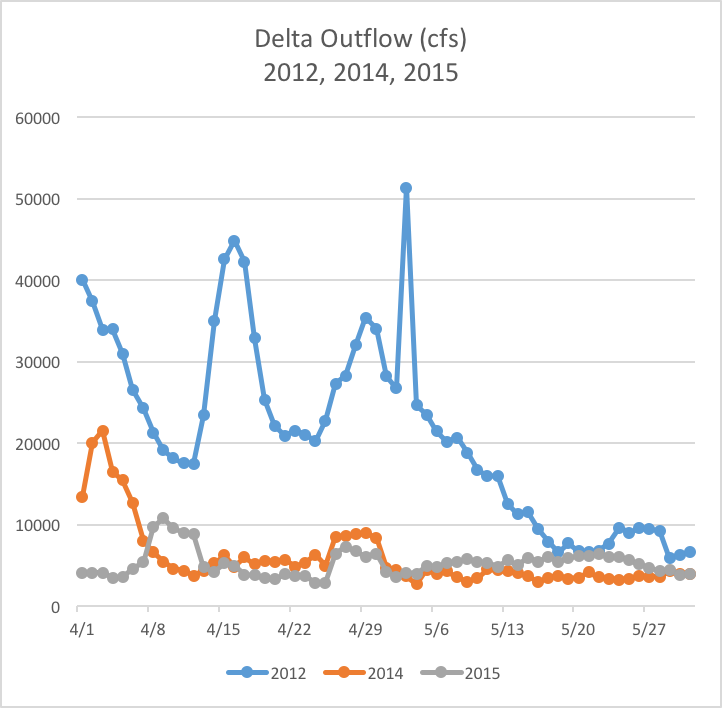During the past four years of drought little has been said about the specific effect of the drought on the Bay, especially the upper Bay. Suisun Bay is a very important part of the San Francisco Bay Estuary as it receives freshwater flow from the Delta and is the low salinity mixing zone of the Bay-Delta ecosystem. Suisun Bay is also critical habitat of many listed estuarine and anadromous fishes. The drought has brought something new: unprecedented high salinities to Suisun Bay from relaxed Bay-Delta Plan Delta outflow and salinity standards. In the chart below (Figure 1) salinity levels as measured by micro-mhos of electrical conductivity (EC) were high (>15,000 EC) at Port Chicago in west Suisun Bay in April and May 2014 and 2015. Normal dry year levels are shown by 2012, when the Delta Outflow standard is 7100 cfs and the Collinsville salinity standard is 2780 EC. In 2014 and 2015, the standards were relaxed to save reservoir storage. The Outflow standard was reduced to 4000 cfs. The salinity standard location was moved upstream into the Delta. Although unregulated flow dominated most of the Apr-May period in 2012 (Figure 2), the regular standards applied in the latter half of May.
The potential ramifications of these unprecedented low outflows and high salinities are wide ranging and substantial.
- Invasive species will increase their presence in the Bay-Delta. Clams, zooplankton, and fish communities will change. Invasive Potamocorbula clams abundance has likely increased and moved further upstream1. More clams mean less plankton and higher selenium concentrations in clams.
“The biomass of the larger copepods is less than it was before the introduction of the clam Corbula amurensis, because of competition for food and grazing by clams on the early life stages of copepods. The resulting low abundance of copepods of suitable size, and the long food chain supporting them, may be contributing factors to the decline in abundance of several estuarine fish species.”2
“Many scientists in the U.S. geological survey, who have been studying the Bay for decades, also concur with Strong, that the clam is likely the culprit”.3
- Young Longfin and Delta Smelt have been forced to rear in the Delta rather than the Suisun Bay. Mysid and Bay shrimp production will be lower.
- Concentration of contaminants will be higher in Suisun Bay, possibly leading to toxicity to plankton, benthic invertebrates, and fish.
- Unbalanced levels of ammonia, nitrogen, and phosphorous nutrients will lead to trophic changes in the plankton community (e.g. more blue green algae and lower diatom production).
- Less inflow to Suisun Bay means less organic carbon and other nutrients necessary to stimulate the estuary’s food chain. Turbidity from river sediment will be lower.
Less inflow to the Delta and less outflow to the Bay also mean more nutrients, plankton, and fish are drawn to the South Delta export pumps. Even with restricted pumping at 1500 cfs limit, the effect is proportional and significant. In reality, Delta outflows are lower than the NDOI estimates provided by DWR and Reclamation. A 14-day running average relaxed standard of 4000 cfs often leads to “real” outflows closer to zero4.
More on the effects of outflow on Suisun Bay can be found at:
http://www.sfestuary.org/wp-content/uploads/2015/03/Estuary-MAR2015-v8a-finalWEB.pdf .


